Contributions of Solar Photovoltaic Systems to Environmental and Socioeconomic Aspects of National Development—A Review
Abstract
:1. Introduction
1.1. Rationale and Background
1.2. Related Literature Survey
1.3. Contributions
1.4. Organization of the Paper
2. The Attenuation of Solar Radiation Reaching the Earth on Horizontal Surfaces
3. The Contributions and Impact of Solar Photovoltaics on National Development
3.1. The Price Reduction and Installation Capacity of Photovoltaic Cells/Modules
3.2. The Trending Position of Current and Future Photovoltaic Power Generation around the World
4. The Importance of Solar Photovoltaics as Compared to Fossil Fuels
5. Photovoltaic Generator, Optimal Sizes, and Electrical Load Management
5.1. Problems of Grid Integration and Its Participation in the Ancillary Market
5.1.1. Market Design
5.1.2. Different Variabilities of Electricity Prices
5.1.3. Instructions among Shareholders of Different PV Modules
5.2. Photovoltaic Materials and Efficiency of Solar Module
6. Solar Material Information and Description
7. Socioeconomic Impacts of Photovoltaic Technology
8. Policies Adopted That Helped to Boost Solar Photovoltaic Systems in Leading Countries
9. Conclusions
10. Future Works
Funding
Data Availability Statement
Acknowledgments
Conflicts of Interest
References
- Luna-Rubio, R.; Trejo-Perea, M.; Vargas-Vázquez, D.; Ríos-Moreno, G.J. Optimal sizing of renewable hybrids energy systems: A review of methodologies. Sol. Energy 2012, 86, 1077–1088. [Google Scholar] [CrossRef]
- Müller-Fürstenberger, G.; Wagner, M. Exploring the environmental Kuznets hypothesis: Theoretical and econometric problems. Ecol. Econ. 2007, 62, 648–660. [Google Scholar] [CrossRef]
- Rathore, N.; Panwar, N.L.; Yettou, F.; Gama, A. A comprehensive review of different types of solar photovoltaic cells and their applications. Int. J. Ambient Energy 2019, 42, 1–18. [Google Scholar] [CrossRef]
- Bukhary, S.; Ahmad, S.; Batista, J. Analyzing land and water requirements for solar deployment in the Southwestern United States. Renew. Sustain. Energy Rev. 2018, 82, 3288–3305. [Google Scholar] [CrossRef]
- MacDougall, A.H.; Friedlingstein, P. The origin and limits of the near proportionality between climate warming and cumulative CO2 emissions. J. Clim. 2015, 28, 4217–4230. [Google Scholar] [CrossRef]
- Trenberth, K.E.; Fasullo, J.T.; Balmaseda, M.A. Earth’s energy imbalance. J. Clim. 2014, 27, 3129–3144. [Google Scholar] [CrossRef]
- Sahu, B.K. A study on global solar PV energy developments and policies with special focus on the top ten solar PV power producing countries. Renew. Sustain. Energy Rev. 2015, 43, 621–634. [Google Scholar] [CrossRef]
- Suganthi, L.; Samuel, A.A. Energy models for demand forecasting—A review. Renew. Sustain. Energy Rev. 2012, 16, 1223–1240. [Google Scholar] [CrossRef]
- Russo, A.C.; Rossi, M.; Germani, M.; Favi, C. Energy Label Directive: Current limitations and guidelines for the improvement. Procedia CIRP 2018, 69, 674–679. [Google Scholar] [CrossRef]
- Labanca, N.; Bertoldi, P. Beyond energy efficiency and individual behaviours: Policy insights from social practice theories. Energy Policy 2018, 115, 494–502. [Google Scholar] [CrossRef]
- Rosenow, J.; Bayer, E. Costs and benefits of Energy Efficiency Obligations: A review of European programmes. Energy Policy 2017, 107, 53–62. [Google Scholar] [CrossRef]
- World Energy Council. Energy Efficiency: A Worldwide Review: Indicators, Policies, Evaluation; World Energy Council: London, UK, 2004. [Google Scholar]
- Wettestad, J.; Gulbrandsen, L.H. The Evolution of Carbon Markets: Design and Diffusion; Routledge: England, UK, 2017; ISBN 135185559X. [Google Scholar]
- Ciulli, F. Institutional Complexity and Sustainable Development in the EU Electricity Sector; Universiteit van Amsterdam: Amsterdam, The Netherlands, 2016; ISBN 9402802177. [Google Scholar]
- Sebitosi, A.B. Energy efficiency, security of supply and the environment in South Africa: Moving beyond the strategy documents. Energy 2008, 33, 1591–1596. [Google Scholar] [CrossRef]
- Tobnaghi, D.M.; Madatov, R.; Naderi, D. The effect of temperature on electrical parameters of solar cells. Int. J. Adv. Res. Electr. Electron. Instrum. Eng. 2013, 2, 6404–6407. [Google Scholar]
- AL-Rousan, N.; Isa, N.A.M.; Desa, M.K.M. Advances in solar photovoltaic tracking systems: A review. Renew. Sustain. Energy Rev. 2018, 82, 2548–2569. [Google Scholar] [CrossRef]
- Tyagi, V.V.; Rahim, N.A.A.; Rahim, N.A.; Selvaraj, J.A.L. Progress in solar PV technology: Research and achievement. Renew. Sustain. Energy Rev. 2013, 20, 443–461. [Google Scholar] [CrossRef]
- Kabir, E.; Kumar, P.; Kumar, S.; Adelodun, A.A.; Kim, K.-H. Solar energy: Potential and future prospects. Renew. Sustain. Energy Rev. 2018, 82, 894–900. [Google Scholar] [CrossRef]
- McGinn, D.; Green, D.; Hinrichs-Rahlwes, R.; Sawyer, S.; Sander, M.; Taylor, R.; Giner-Reichl, I.; Teske, S.; Lehmann, H.; Hales, D. Renewables 2013, Global Status Report (REN21). 2013. Available online: www.ren21.net (accessed on 1 June 2021).
- Rabaia, M.K.H.; Abdelkareem, M.A.; Sayed, E.T.; Elsaid, K.; Chae, K.-J.; Wilberforce, T.; Olabi, A.G. Environmental impacts of solar energy systems: A review. Sci. Total Environ. 2021, 754, 141989. [Google Scholar] [CrossRef]
- Tawalbeh, M.; Al-Othman, A.; Kafiah, F.; Abdelsalam, E.; Almomani, F.; Alkasrawi, M. Environmental impacts of solar photovoltaic systems: A critical review of recent progress and future outlook. Sci. Total Environ. 2020, 759, 143528. [Google Scholar] [CrossRef]
- Al Dulaimi, N.H.; Alkhalidi, D.A. Design of an Off–Grid Solar PV System for a Rural Shelter; School of Natural Resources Engineering Management: Amman, Jordan, 2017. [Google Scholar]
- Benedetti, D.; Agnelli, J.; Gagliardi, A.; Dini, P.; Saponara, S. Design of an Off-Grid Photovoltaic Carport for a Full Electric Vehicle Recharging. In Proceedings of the 2020 IEEE International Conference on Environment and Electrical Engineering and 2020 IEEE Industrial and Commercial Power Systems Europe (EEEIC/I&CPS Europe), Madrid, Spain, 9–12 June 2020; pp. 1–6. [Google Scholar]
- Bhattacharyya, S.C. Mini-grid based electrification in Bangladesh: Technical configuration and business analysis. Renew. Energy 2015, 75, 745–761. [Google Scholar] [CrossRef]
- Harrouz, A.; Abbes, M.; Colak, I.; Kayisli, K. Smart grid and renewable energy in Algeria. In Proceedings of the 2017 IEEE 6th International Conference on Renewable Energy Research and Applications (ICRERA), San Diego, CA, USA, 5–8 November 2017; pp. 1166–1171. [Google Scholar]
- Thirugnanasambandam, M.; Iniyan, S.; Goic, R. A review of solar thermal technologies. Renew. Sustain. Energy Rev. 2010, 14, 312–322. [Google Scholar] [CrossRef]
- Beylot, A.; Payet, J.; Puech, C.; Adra, N.; Jacquin, P.; Blanc, I.; Beloin-Saint-Pierre, D. Environmental impacts of large-scale grid-connected ground-mounted PV installations. Renew. Energy 2014, 61, 2–6. [Google Scholar] [CrossRef]
- Mahmoud, M.; Ramadan, M.; Naher, S.; Pullen, K.; Olabi, A.-G. The impacts of different heating systems on the environment: A review. Sci. Total Environ. 2020, 766, 142625. [Google Scholar] [CrossRef]
- Fong, K.F.; Chow, T.T.; Lee, C.K.; Lin, Z.; Chan, L.S. Comparative study of different solar cooling systems for buildings in subtropical city. Sol. Energy 2010, 84, 227–244. [Google Scholar] [CrossRef]
- McCubbin, D.; Sovacool, B.K. Quantifying the health and environmental benefits of wind power to natural gas. Energy Policy 2013, 53, 429–441. [Google Scholar] [CrossRef]
- Liu, S.-Y.; Perng, Y.-H.; Ho, Y.-F. The effect of renewable energy application on Taiwan buildings: What are the challenges and strategies for solar energy exploitation? Renew. Sustain. Energy Rev. 2013, 28, 92–106. [Google Scholar] [CrossRef]
- Bouich, A.; Marí-Guaita, J.; Sahraoui, B.; Palacios, P.; Marí, B. Tetrabutylammonium (TBA)-Doped Methylammonium Lead Iodide: High Quality and Stable Perovskite Thin Films. Front. Energy Res 2022, 10, 840817. [Google Scholar] [CrossRef]
- Elsaid, K.; Sayed, E.T.; Yousef, B.A.A.; Rabaia, M.K.H.; Abdelkareem, M.A.; Olabi, A.G. Recent progress on the utilization of waste heat for desalination: A review. Energy Convers. Manag. 2020, 221, 113105. [Google Scholar] [CrossRef]
- Olabi, A.G.; Elsaid, K.; Rabaia, M.K.H.; Askalany, A.A.; Abdelkareem, M.A. Waste heat-driven desalination systems: Perspective. Energy 2020, 209, 118373. [Google Scholar] [CrossRef]
- Brough, D.; Mezquita, A.; Ferrer, S.; Segarra, C.; Chauhan, A.; Almahmoud, S.; Khordehgah, N.; Ahmad, L.; Middleton, D.; Sewell, H.I. An experimental study and computational validation of waste heat recovery from a lab scale ceramic kiln using a vertical multi-pass heat pipe heat exchanger. Energy 2020, 208, 118325. [Google Scholar] [CrossRef]
- Olabi, A.G.; Wilberforce, T.; Sayed, E.T.; Elsaid, K.; Rezk, H.; Abdelkareem, M.A. Recent progress of graphene based nanomaterials in bioelectrochemical systems. Sci. Total Environ. 2020, 749, 141225. [Google Scholar] [CrossRef]
- Abdelkareem, M.A.; Sayed, E.T.; Nakagawa, N. Significance of diffusion layers on the performance of liquid and vapor feed passive direct methanol fuel cells. Energy 2020, 209, 118492. [Google Scholar] [CrossRef]
- Abdelkareem, M.A.; Sayed, E.T.; Mohamed, H.O.; Obaid, M.; Rezk, H.; Chae, K.-J. Nonprecious anodic catalysts for low-molecular-hydrocarbon fuel cells: Theoretical consideration and current progress. Prog. Energy Combust. Sci. 2020, 77, 100805. [Google Scholar] [CrossRef]
- Abdelkareem, M.A.; El Haj Assad, M.; Sayed, E.T.; Soudan, B. Recent progress in the use of renewable energy sources to power water desalination plants. Desalination 2018, 435, 97–113. [Google Scholar] [CrossRef]
- Souliotis, M.; Arnaoutakis, N.; Panaras, G.; Kavga, A.; Papaefthimiou, S. Experimental study and Life Cycle Assessment (LCA) of Hybrid Photovoltaic/Thermal (PV/T) solar systems for domestic applications. Renew. Energy 2018, 126, 708–723. [Google Scholar] [CrossRef]
- Rezk, H.; Mazen, A.-O.; Gomaa, M.R.; Tolba, M.A.; Fathy, A.; Abdelkareem, M.A.; Olabi, A.G.; Abou Hashema, M. A novel statistical performance evaluation of most modern optimization-based global MPPT techniques for partially shaded PV system. Renew. Sustain. Energy Rev. 2019, 115, 109372. [Google Scholar] [CrossRef]
- Mahmoud, M.; Ramadan, M.; Olabi, A.-G.; Pullen, K.; Naher, S. A review of mechanical energy storage systems combined with wind and solar applications. Energy Convers. Manag. 2020, 210, 112670. [Google Scholar] [CrossRef]
- Inayat, A.; Raza, M. District cooling system via renewable energy sources: A review. Renew. Sustain. Energy Rev. 2019, 107, 360–373. [Google Scholar] [CrossRef]
- Wilberforce, T.; Baroutaji, A.; El Hassan, Z.; Thompson, J.; Soudan, B.; Olabi, A.G. Prospects and challenges of concentrated solar photovoltaics and enhanced geothermal energy technologies. Sci. Total Environ. 2019, 659, 851–861. [Google Scholar] [CrossRef]
- Kumar, M.; Dar, M.A.; Katiyar, A.; Agrawal, R.; Shenai, P.M.; Srinivasan, V. Role of magnetization on catalytic pathways of non-oxidative methane activation on neutral iron carbide clusters. Phys. Chem. Chem. Phys. 2022, 24, 11668–11679. [Google Scholar] [CrossRef]
- Grant, C.; Garcia, J.; Hicks, A. Environmental payback periods of multi-crystalline silicon photovoltaics in the United States–How prioritizing based on environmental impact compares to solar intensity. Sustain. Energy Technol. Assess. 2020, 39, 100723. [Google Scholar] [CrossRef]
- Uctug, F.G.; Azapagic, A. Life cycle environmental impacts of domestic solar water heaters in Turkey: The effect of different climatic regions. Sci. Total Environ. 2018, 622, 1202–1216. [Google Scholar] [CrossRef]
- Klugmann-Radziemska, E.; Kuczyńska-Łażewska, A. The use of recycled semiconductor material in crystalline silicon photovoltaic modules production-A life cycle assessment of environmental impacts. Sol. Energy Mater. Sol. Cells 2020, 205, 110259. [Google Scholar] [CrossRef]
- Čabo, F.G.; Nižetić, S.; Giama, E.; Papadopoulos, A. Techno-economic and environmental evaluation of passive cooled photovoltaic systems in Mediterranean climate conditions. Appl. Therm. Eng. 2020, 169, 114947. [Google Scholar] [CrossRef]
- Lizin, S.; Van Passel, S.; De Schepper, E.; Maes, W.; Lutsen, L.; Manca, J.; Vanderzande, D. Life cycle analyses of organic photovoltaics: A review. Energy Environ. Sci. 2013, 6, 3136–3149. [Google Scholar] [CrossRef]
- Gerbinet, S.; Belboom, S.; Léonard, A. Life Cycle Analysis (LCA) of photovoltaic panels: A review. Renew. Sustain. Energy Rev. 2014, 38, 747–753. [Google Scholar] [CrossRef]
- Kommalapati, R.; Kadiyala, A.; Shahriar, M.; Huque, Z. Review of the life cycle greenhouse gas emissions from different photovoltaic and concentrating solar power electricity generation systems. Energies 2017, 10, 350. [Google Scholar] [CrossRef]
- El-Bialy, E.; Shalaby, S.M.; Kabeel, A.E.; Fathy, A.M. Cost analysis for several solar desalination systems. Desalination 2016, 384, 12–30. [Google Scholar] [CrossRef]
- Chen, Z.; Ivan Su, S.I. Dual competing photovoltaic supply chains: A socialwelfare maximization perspective. Int. J. Environ. Res. Public Health 2017, 14, 1416. [Google Scholar] [CrossRef]
- Amin, M.R.; Mishu, M.K.; Al Faysal, A.; Nizam, M.R. Design and implementation of opto-isolator based low cost digital anemometer with wind direction monitoring system. In Proceedings of the Informatics, Electronics and Vision (ICIEV), 2016 5th International Conference, Dhaka, Bangladesh, 13–14 May 2016; pp. 133–138. [Google Scholar]
- Farjana, S.H.; Huda, N.; Mahmud, M.A.P.; Saidur, R. Solar process heat in industrial systems–A global review. Renew. Sustain. Energy Rev. 2018, 82, 2270–2286. [Google Scholar] [CrossRef]
- Hafez, A.A.; Nassar, Y.F.; Hammdan, M.I.; Alsadi, S.Y. Technical and economic feasibility of utility-scale solar energy conversion systems in Saudi Arabia. Iran. J. Sci. Technol. Trans. Electr. Eng. 2020, 44, 213–225. [Google Scholar]
- Espinosa, N.; Hösel, M.; Jørgensen, M.; Krebs, F.C. Large scale deployment of polymer solar cells on land, on sea and in the air. Energy Environ. Sci. 2014, 7, 855–866. [Google Scholar] [CrossRef]
- Espinosa, N.; Zimmermann, Y.-S.; dos Reis Benatto, G.A.; Lenz, M.; Krebs, F.C. Outdoor fate and environmental impact of polymer solar cells through leaching and emission to rainwater and soil. Energy Environ. Sci. 2016, 9, 1674–1680. [Google Scholar] [CrossRef]
- Shafique, M.; Luo, X.; Zuo, J. Photovoltaic-green roofs: A review of benefits, limitations, and trends. Sol. Energy 2020, 202, 485–497. [Google Scholar] [CrossRef]
- Akinyele, D.; Belikov, J.; Levron, Y. Battery storage technologies for electrical applications: Impact in stand-alone photovoltaic systems. Energies 2017, 10, 1760. [Google Scholar] [CrossRef]
- Pellow, M.A.; Ambrose, H.; Mulvaney, D.; Betita, R.; Shaw, S. Research gaps in environmental life cycle assessments of lithium ion batteries for grid-scale stationary energy storage systems: End-of-life options and other issues. Sustain. Mater. Technol. 2020, 23, e00120. [Google Scholar] [CrossRef]
- Wang, F.; Deng, Y.; Yuan, C. Life cycle assessment of lithium oxygen battery for electric vehicles. J. Clean. Prod. 2020, 264, 121339. [Google Scholar] [CrossRef]
- Ardente, F.; Beccali, G.; Cellura, M.; Brano, V. Lo Life cycle assessment of a solar thermal collector: Sensitivity analysis, energy and environmental balances. Renew. Energy 2005, 30, 109–130. [Google Scholar] [CrossRef]
- Kalogirou, S. Thermal performance, economic and environmental life cycle analysis of thermosiphon solar water heaters. Sol. energy 2009, 83, 39–48. [Google Scholar] [CrossRef]
- Mousa, O.B.; Kara, S.; Taylor, R.A. Comparative energy and greenhouse gas assessment of industrial rooftop-integrated PV and solar thermal collectors. Appl. Energy 2019, 241, 113–123. [Google Scholar] [CrossRef]
- Atilgan, B.; Azapagic, A. Renewable electricity in Turkey: Life cycle environmental impacts. Renew. Energy 2016, 89, 649–657. [Google Scholar] [CrossRef]
- Hou, G.; Sun, H.; Jiang, Z.; Pan, Z.; Wang, Y.; Zhang, X.; Zhao, Y.; Yao, Q. Life cycle assessment of grid-connected photovoltaic power generation from crystalline silicon solar modules in China. Appl. Energy 2016, 164, 882–890. [Google Scholar] [CrossRef]
- Ward, D.J.; Inderwildi, O.R. Global and local impacts of UK renewable energy policy. Energy Environ. Sci. 2013, 6, 18–24. [Google Scholar] [CrossRef]
- Grant, C.A.; Hicks, A.L. Effect of manufacturing and installation location on environmental impact payback time of solar power. Clean Technol. Environ. Policy 2020, 22, 187–196. [Google Scholar] [CrossRef]
- Bianchini, A.; Gambuti, M.; Pellegrini, M.; Saccani, C. Performance analysis and economic assessment of different photovoltaic technologies based on experimental measurements. Renew. Energy 2016, 85, 1–11. [Google Scholar] [CrossRef]
- Apeh, O.O.; Overen, O.K.; Meyer, E.L. Monthly, seasonal and yearly assessments of global solar radiation, clearness index and diffuse fractions in alice, south africa. Sustainability 2021, 13, 2135. [Google Scholar] [CrossRef]
- Widén, J.; Munkhammar, J. Solar Radiation Theory; Uppsala University: Uppsala, Sweden, 2019. [Google Scholar]
- Collares-Pereira, M.; Rabl, A. The average distribution of solar radiation-correlations between diffuse and hemispherical and between daily and hourly insolation values. Sol. Energy 1979, 22, 155–164. [Google Scholar] [CrossRef]
- Al-Rawahi, N.Z.; Zurigat, Y.H.; Al-Azri, N.A. Prediction of hourly solar radiation on horizontal and inclined surfaces for Muscat/Oman. J. Eng. Res. 2011, 8, 19–31. [Google Scholar] [CrossRef]
- Son, J.; Jeong, S.; Park, H.; Park, C.-E. The effect of particulate matter on solar photovoltaic power generation over the Republic of Korea. Environ. Res. Lett. 2020, 15, 84004. [Google Scholar] [CrossRef]
- Brano, V.L.; Orioli, A.; Ciulla, G.; Di Gangi, A. An improved five-parameter model for photovoltaic modules. Sol. Energy Mater. Sol. Cells 2010, 94, 1358–1370. [Google Scholar] [CrossRef]
- Infield, D.; Freris, L. Renewable Energy in Power Systems; John Wiley & Sons: Hoboken, NJ, USA, 2020; ISBN 1118649931. [Google Scholar]
- REN21. Global Status Report; REN21 Secretariat: Paris, France, 2018. [Google Scholar]
- Aman, M.M.; Solangi, K.H.; Hossain, M.S.; Badarudin, A.; Jasmon, G.B.; Mokhlis, H.; Bakar, A.H.A.; Kazi, S.N. A review of Safety, Health and Environmental (SHE) issues of solar energy system. Renew. Sustain. Energy Rev. 2015, 41, 1190–1204. [Google Scholar] [CrossRef]
- Pearlmutter, D.; Theochari, D.; Nehls, T.; Pinho, P.; Piro, P.; Korolova, A.; Papaefthimiou, S.; Mateo, M.C.G.; Calheiros, C.; Zluwa, I. Enhancing the circular economy with nature-based solutions in the built urban environment: Green building materials, systems and sites. Blue-Green Syst. 2020, 2, 46–72. [Google Scholar] [CrossRef]
- Harris, J.M.; Roach, B. Environmental and Natural Resource Economics: A Contemporary Approach; Routledge: England, UK, 2017; ISBN 1317216210. [Google Scholar]
- Wirth, H.; Schneider, K. Recent Facts about Photovoltaics in Germany; Fraunhofer ISE: Freiburg, Germany, 2015; Volume 92. [Google Scholar]
- Morata, F.; Sandoval, I.S. European Energy Policy: An Environmental Approach; Edward Elgar Publishing: Cheltenham, UK, 2012; ISBN 0857939211. [Google Scholar]
- Nemet, G.F. Beyond the learning curve: Factors influencing cost reductions in photovoltaics. Energy Policy 2006, 34, 3218–3232. [Google Scholar] [CrossRef]
- Gul, M.; Kotak, Y.; Muneer, T. Review on recent trend of solar photovoltaic technology. Energy Explor. Exploit. 2016, 34, 485–526. [Google Scholar] [CrossRef]
- Feldman, D.; Barbose, G.; Margolis, R.; Bolinger, M.; Chung, D.; Fu, R.; Seel, J.; Davidson, C.; Darghouth, N.; Wiser, R. Photovoltaic System Pricing Trends: Historical, Recent, and Near-Term Projections, 2015th ed.; Lawrence Berkeley National Laboratory: Berkeley, CA, USA, 2015. Available online: https://www.osti.gov/ (accessed on 21 July 2022).
- IRENA. Off-Grid Renewable Energy Solutions to Expand Electricity Access: An Opportunity Not to Be Missed; International Renewable Energy Agency: Abu Dhabi, United Arab Emirates, 2019; p. 144. [Google Scholar]
- Obi, M.; Bass, R. Trends and challenges of grid-connected photovoltaic systems–A review. Renew. Sustain. Energy Rev. 2016, 58, 1082–1094. [Google Scholar] [CrossRef]
- Needleman, D.B.; Poindexter, J.R.; Kurchin, R.C.; Peters, I.M.; Wilson, G.; Buonassisi, T. Economically sustainable scaling of photovoltaics to meet climate targets. Energy Environ. Sci. 2016, 9, 2122–2129. [Google Scholar] [CrossRef]
- Peng, H.; Liu, Y. How government subsidies promote the growth of entrepreneurial companies in clean energy industry: An empirical study in China. J. Clean. Prod. 2018, 188, 508–520. [Google Scholar] [CrossRef]
- Solangi, K.H.; Islam, M.R.; Saidur, R.; Rahim, N.A.; Fayaz, H. A review on global solar energy policy. Renew. Sustain. Energy Rev. 2011, 15, 2149–2163. [Google Scholar] [CrossRef]
- Timilsina, G.R.; Kurdgelashvili, L.; Narbel, P.A. Solar energy: Markets, economics and policies. Renew. Sustain. Energy Rev. 2012, 16, 449–465. [Google Scholar] [CrossRef]
- Pitt, D.; Congreve, A. Collaborative approaches to local climate change and clean energy initiatives in the USA and England. Local Environ. 2017, 22, 1124–1141. [Google Scholar] [CrossRef]
- Lau, L.C.; Tan, K.T.; Lee, K.T.; Mohamed, A.R. A comparative study on the energy policies in Japan and Malaysia in fulfilling their nations’ obligations towards the Kyoto Protocol. Energy Policy 2009, 37, 4771–4778. [Google Scholar] [CrossRef]
- Liu, L.; Wang, Z.; Zhang, H.; Xue, Y. Solar energy development in China—A review. Renew. Sustain. Energy Rev. 2010, 14, 301–311. [Google Scholar] [CrossRef]
- Modise, D.; Mahotas, V. Overview of the South African Energy Sector Sources of Power. 2014. Available online: http://www.energy.gov.za (accessed on 21 July 2022).
- Petroleum, B. BP Statistical Review of world energy 2015. Br. Pet 2017, 66, 1–52. [Google Scholar]
- Wu, H.; Hou, Y. Recent development of grid-connected PV systems in China. Energy Procedia 2011, 12, 462–470. [Google Scholar] [CrossRef]
- Hart, D.; Birson, K. Deployment of Solar Photovoltaic Generation Capacity in the United States; Schar Sch. Policy Gov. Georg. Mason Univ. Prep. Off. Energy Policy Syst. Anal. US Dep. Energ, 2016. Available online: https://diggingintodata.org (accessed on 1 June 2021).
- Ahmad, L.; Khordehgah, N.; Malinauskaite, J.; Jouhara, H. Recent advances and applications of solar photovoltaics and thermal technologies. Energy 2020, 207, 118254. [Google Scholar] [CrossRef]
- Pachauri, R.K.; Allen, M.R.; Barros, V.R.; Broome, J.; Cramer, W.; Christ, R.; Church, J.A.; Clarke, L.; Dahe, Q.; Dasgupta, P. Climate Change 2014: Synthesis Report. Contribution of Working Groups I, II and III to the Fifth Assessment Report of the Intergovernmental Panel on Climate Change; IPCC: Geneva, Switzerland, 2014; ISBN 9291691437. [Google Scholar]
- Moriarty, P.; Honnery, D. Can renewable energy power the future? Energy Policy 2016, 93, 3–7. [Google Scholar] [CrossRef]
- Meyer, E.L. Investigation of Properties and Energy Rating of Photovoltaic Modules. Ph.D. Thesis, Universiteit van Port Elizabeth, Port Elizabeth, South Africa, 1999. Available online: https://journals.co.za/doi/ (accessed on 21 July 2022).
- Li, J.; Danzer, M.A. Optimal charge control strategies for stationary photovoltaic battery systems. J. Power Sources 2014, 258, 365–373. [Google Scholar] [CrossRef]
- Borowy, B.S.; Salameh, Z.M. Optimum photovoltaic array size for a hybrid wind/PV system. IEEE Trans. Energy Convers. 1994, 9, 482–488. [Google Scholar] [CrossRef]
- Mendez, L.; Narvarte, L.; Marsinach, A.G.; Izquierdo, P.; Carrasco, L.M.; Eyras, R. Centralized stand alone PV system in microgrid in Morocco. In Proceedings of the 3rd World Conference on Photovoltaic Energy Conversion, Osaka, Japan, 11–18 May 2003; Volume 3, pp. 2326–2328. [Google Scholar]
- Awasthi, A.; Shukla, A.K.; SR, M.M.; Dondariya, C.; Shukla, K.N.; Porwal, D.; Richhariya, G. Review on sun tracking technology in solar PV system. Energy Reports 2020, 6, 392–405. [Google Scholar] [CrossRef]
- Sun, J.; Wang, R.; Hong, H.; Liu, Q. An optimized tracking strategy for small-scale double-axis parabolic trough collector. Appl. Therm. Eng. 2017, 112, 1408–1420. [Google Scholar] [CrossRef]
- Cifor, A.; Denholm, P.; Ela, E.; Hodge, B.-M.; Reed, A. The policy and institutional challenges of grid integration of renewable energy in the western United States. Util. Policy 2015, 33, 34–41. [Google Scholar]
- Shen, J.; Cheng, C.; Jia, Z.; Zhang, Y.; Lv, Q.; Cai, H.; Wang, B.; Xie, M. Impacts, challenges and suggestions of the electricity market for hydro-dominated power systems in China. Renew. Energy 2022, 187, 743–759. [Google Scholar] [CrossRef]
- McCann, M.J.; Catchpole, K.R.; Weber, K.J.; Blakers, A.W. A review of thin-film crystalline silicon for solar cell applications. Part 1: Native substrates. Sol. Energy Mater. Sol. Cells 2001, 68, 135–171. [Google Scholar] [CrossRef]
- Böer, K.W. Cadmium sulfide enhances solar cell efficiency. Energy Convers. Manag. 2011, 52, 426–430. [Google Scholar]
- Gorter, T.; Reinders, A.H.M.E. A comparison of 15 polymers for application in photovoltaic modules in PV-powered boats. Appl. Energy 2012, 92, 286–297. [Google Scholar] [CrossRef]
- Razykov, T.M.; Ferekides, C.S.; Morel, D.; Stefanakos, E.; Ullal, H.S.; Upadhyaya, H.M. Solar photovoltaic electricity: Current status and future prospects. Sol. Energy 2011, 85, 1580–1608. [Google Scholar] [CrossRef]
- Schleicher-Tappeser, R. How renewables will change electricity markets in the next five years. Energy Policy 2012, 48, 64–75. [Google Scholar] [CrossRef]
- Iles, P.A. Evolution of space solar cells. Sol. Energy Mater. Sol. Cells 2001, 68, 1–13. [Google Scholar] [CrossRef]
- Vrielink, J.A.M.; Tiggelaar, R.M.; Gardeniers, J.G.E.; Lefferts, L. Applicability of X-ray fluorescence spectroscopy as method to determine thickness and composition of stacks of metal thin films: A comparison with imaging and profilometry. Thin Solid Films 2012, 520, 1740–1744. [Google Scholar] [CrossRef]
- Parida, B.; Iniyan, S.; Goic, R. A review of solar photovoltaic technologies. Renew. Sustain. Energy Rev. 2011, 15, 1625–1636. [Google Scholar] [CrossRef]
- Boutchich, M.; Alvarez, J.; Diouf, D.; i Cabarrocas, P.R.; Liao, M.; Masataka, I.; Koide, Y.; Kleider, J.-P. Amorphous silicon diamond based heterojunctions with high rectification ratio. J. Non. Cryst. Solids 2012, 358, 2110–2113. [Google Scholar] [CrossRef]
- Radue, C.; Van Dyk, E.E.; Macabebe, E.Q. Analysis of performance and device parameters of CIGS PV modules deployed outdoors. Thin Solid Films 2009, 517, 2383–2385. [Google Scholar] [CrossRef]
- Chopra, K.L.; Paulson, P.D.; Dutta, V. Thin-film solar cells: An overview. Prog. Photovoltaics Res. Appl. 2004, 12, 69–92. [Google Scholar] [CrossRef]
- Hegedus, S.S.; McCandless, B.E. CdTe contacts for CdTe/CdS solar cells: Effect of Cu thickness, surface preparation and recontacting on device performance and stability. Sol. Energy Mater. Sol. Cells 2005, 88, 75–95. [Google Scholar] [CrossRef]
- Soliman, M.M.; Shabana, M.M.; Abulfotuh, F. CdS/CdTe solar cell using sputtering technique. Renew. Energy 1996, 8, 386–389. [Google Scholar] [CrossRef]
- Repins, I.; Contreras, M.A.; Egaas, B.; DeHart, C.; Scharf, J.; Perkins, C.L.; To, B.; Noufi, R. 19.9%-efficient ZnO/CdS/CuInGaSe2 solar cell with 81.2% fill factor. Prog. Photovolt. Res. Appl. 2008, 16, 235–239. [Google Scholar] [CrossRef]
- Meyer, E.L.; Van Dyk, E.E. Characterization of degradation in thin-film photovoltaic module performance parameters. Renew. Energy 2003, 28, 1455–1469. [Google Scholar] [CrossRef]
- Goetzberger, A.; Hebling, C.; Schock, H.-W. Photovoltaic materials, history, status and outlook. Mater. Sci. Eng. R Reports 2003, 40, 1–46. [Google Scholar] [CrossRef]
- Peumans, P.; Yakimov, A.; Forrest, S.R. Small molecular weight organic thin-film photodetectors and solar cells. J. Appl. Phys. 2003, 93, 3693–3723. [Google Scholar] [CrossRef]
- Wu, L.; Tian, W.; Jiang, X. Silicon-based solar cell system with a hybrid PV module. Sol. Energy Mater. Sol. Cells 2005, 87, 637–645. [Google Scholar] [CrossRef]
- Nazeeruddin, M.K.; Baranoff, E.; Grätzel, M. Dye-sensitized solar cells: A brief overview. Sol. Energy 2011, 85, 1172–1178. [Google Scholar] [CrossRef]
- Philibert, C.; Frankl, P.; Tam, C.; Abdelilah, Y.; Bahar, H.; Marchais, Q.; Wiesner, H. Technology Roadmap: Solar Photovoltaic Energy; International Energy Agency: Paris, France, 2014. [Google Scholar]
- Grau, T.; Huo, M.; Neuhoff, K. Survey of photovoltaic industry and policy in Germany and China. Energy Policy 2012, 51, 20–37. [Google Scholar] [CrossRef]
- Sen, S.; Ganguly, S. Opportunities, barriers and issues with renewable energy development–A discussion. Renew. Sustain. Energy Rev. 2017, 69, 1170–1181. [Google Scholar] [CrossRef]
- Whiteman, A.; Esparrago, J.; Elsayed, S. Renewable Energy Statistics 2018; International Renewable Energy Agency: Abu Dhabi, United Arab Emirates, 2018. [Google Scholar]
- IRENA. Future of Solar Photovoltaic: Deployment, Investment, Technology, Grid Integration and Socio-Economic Aspects (A Global Energy Transformation: Paper); Abu Dhabi. 2019. ISBN 9789292601553. Available online: www.irena.org/publications (accessed on 1 June 2021).
- Observ, E.R. The state of renewable energies in europe: Frankfurt School of Finance and Management (DE), Fraunhofer ISI (DE) and Statistics Netherlands (NL), Report, 18th EuroObserv’ER, Edition. 2013; Volume 33, p. 103.
- Boshell, F.; Gielen, D.; Roesch, R.; Anisie, A.; Salgado, A.; Ratka, S. Innovation Driving The Energy Transition. In Global Innovation Index 2018; IRENA: Abu Dhabi, United Arab Emirates, 2018; p. 97. [Google Scholar]
- IEA. Renewable Energy and Jobs–Annual Review; IEA: Abu Dhabi, United Arab Emirate, 2020; ISBN 978-92-9260-266-6. [Google Scholar]
- Solar Generation, V. Solar Electricity for over One Billion People and Two Million Jobs by 2020; European Photovoltaic Industry Association: Brussels, Belgium, 2008. [Google Scholar]
- Heavner, B.; Del Chiaro, B. Renewable Energy and Jobs: Employment Impacts of Developing Markets for Renewables in California; Environment California Research & Policy Center: Sacramento, CA, USA, 2003. [Google Scholar]
- Zervos, A. Renewable Energy Technology Roadmap 20% by 2020; European Renewable Energy Council: Brussels, Belgium, 2009. [Google Scholar]
- IRENA. Renewable Energy and Jobs-Annual Review 2018; International Renewable Energy Agency: Abu Dhabi, United Arab Emirates, 2018; pp. 1–28. [Google Scholar]
- Sterzinger, G. Jobs and Renewable Energy Project; IRENA: Abu Dhabi, United Arab Emirates, 2006. [Google Scholar]
- Del Rio, P.; Burguillo, M. An empirical analysis of the impact of renewable energy deployment on local sustainability. Renew. Sustain. Energy Rev. 2009, 13, 1314–1325. [Google Scholar] [CrossRef]
- Sastresa, E.L.; Usón, A.A.; Bribián, I.Z.; Scarpellini, S. Local impact of renewables on employment: Assessment methodology and case study. Renew. Sustain. Energy Rev. 2010, 14, 679–690. [Google Scholar] [CrossRef]
- Moreno, B.; Lopez, A.J. The effect of renewable energy on employment. The case of Asturias (Spain). Renew. Sustain. Energy Rev. 2008, 12, 732–751. [Google Scholar] [CrossRef]
- Cameron, L.; Van Der Zwaan, B. Employment factors for wind and solar energy technologies: A literature review. Renew. Sustain. Energy Rev. 2015, 45, 160–172. [Google Scholar] [CrossRef]
- Burns, J.E.; Kang, J.-S. Comparative economic analysis of supporting policies for residential solar PV in the United States: Solar Renewable Energy Credit (SREC) potential. Energy Policy 2012, 44, 217–225. [Google Scholar] [CrossRef]
- Fouquet, D.; Johansson, T.B. European renewable energy policy at crossroads—Focus on electricity support mechanisms. Energy Policy 2008, 36, 4079–4092. [Google Scholar] [CrossRef]
- Sarasa-Maestro, C.J.; Dufo-López, R.; Bernal-Agustín, J.L. Photovoltaic remuneration policies in the European Union. Energy Policy 2013, 55, 317–328. [Google Scholar] [CrossRef]
- Gutermuth, P.-G. Regulatory and institutional measures by the state to enhance the deployment of renewable energies: German experiences. Sol. Energy 2000, 69, 205–213. [Google Scholar] [CrossRef]
- Erge, T.; Hoffmann, V.U.; Kiefer, K. The German experience with grid-connected PV-systems. Sol. Energy 2001, 70, 479–487. [Google Scholar] [CrossRef]
- Jahn, U.; Nasse, W. Performance analysis and reliability of grid-connected PV systems in IEA countries. In Proceedings of the 3rd World Conference on Photovoltaic Energy Conversion, Osaka, Japan, 11–18 May 2003; Volume 3, pp. 2148–2151. [Google Scholar]
- Weiss, I.; Sprau, P.; Helm, P. The German PV solar power financing schemes reflected on the German PV market. In Proceedings of the 3rd World Conference on Photovoltaic Energy Conversion, Osaka, Japan, 11–18 May 2003; Volume 3, pp. 2592–2595. [Google Scholar]
- Stritih, U.; Zupan, G.; Butala, V. Review of green electricity production in Slovenia. Renew. Sustain. Energy Rev. 2007, 11, 2201–2208. [Google Scholar] [CrossRef]
- Zahedi, A. Development of an economical model to determine an appropriate feed-in tariff for grid-connected solar PV electricity in all states of Australia. Renew. Sustain. Energy Rev. 2009, 13, 871–878. [Google Scholar] [CrossRef]
- Focacci, A. Residential plants investment appraisal subsequent to the new supporting photovoltaic economic mechanism in Italy. Renew. Sustain. Energy Rev. 2009, 13, 2710–2715. [Google Scholar] [CrossRef]
- Jia, F.; Sun, H.; Koh, L. Global solar photovoltaic industry: An overview and national competitiveness of Taiwan. J. Clean. Prod. 2016, 126, 550–562. [Google Scholar] [CrossRef]
- Poullikkas, A. Parametric cost–benefit analysis for the installation of photovoltaic parks in the island of Cyprus. Energy Policy 2009, 37, 3673–3680. [Google Scholar] [CrossRef]
- Papadopoulos, A.M.; Karteris, M.M. An assessment of the Greek incentives scheme for photovoltaics. Energy Policy 2009, 37, 1945–1952. [Google Scholar] [CrossRef]
- Celik, A.N.; Muneer, T.; Clarke, P. A review of installed solar photovoltaic and thermal collector capacities in relation to solar potential for the EU-15. Renew. Energy 2009, 34, 849–856. [Google Scholar] [CrossRef]
- Ren, H.; Gao, W.; Ruan, Y. Economic optimization and sensitivity analysis of photovoltaic system in residential buildings. Renew. Energy 2009, 34, 883–889. [Google Scholar] [CrossRef]
- Luethi, S. Effective deployment of photovoltaics in the Mediterranean countries: Balancing policy risk and return. Sol. Energy 2010, 84, 1059–1071. [Google Scholar] [CrossRef]
- Dusonchet, L.; Telaretti, E. Economic analysis of different supporting policies for the production of electrical energy by solar photovoltaics in western European Union countries. Energy Policy 2010, 38, 3297–3308. [Google Scholar] [CrossRef]
- Dincer, F. The analysis on photovoltaic electricity generation status, potential and policies of the leading countries in solar energy. Renew. Sustain. Energy Rev. 2011, 15, 713–720. [Google Scholar] [CrossRef]
- Cucchiella, F.; D’Adamo, I. Feasibility study of developing photovoltaic power projects in Italy: An integrated approach. Renew. Sustain. Energy Rev. 2012, 16, 1562–1576. [Google Scholar] [CrossRef]
- Orioli, A.; Di Gangi, A. Effects of the Italian financial crisis on the photovoltaic dissemination in a southern city. Energy 2013, 62, 173–184. [Google Scholar] [CrossRef]
- de Keizer, A.C.; Alsema, E.A.; van Sark, W. Socio-Economic Aspects of Photovoltaic Energy Technology. 2006. Available online: https://www.researchgate.net/ (accessed on 21 July 2022).
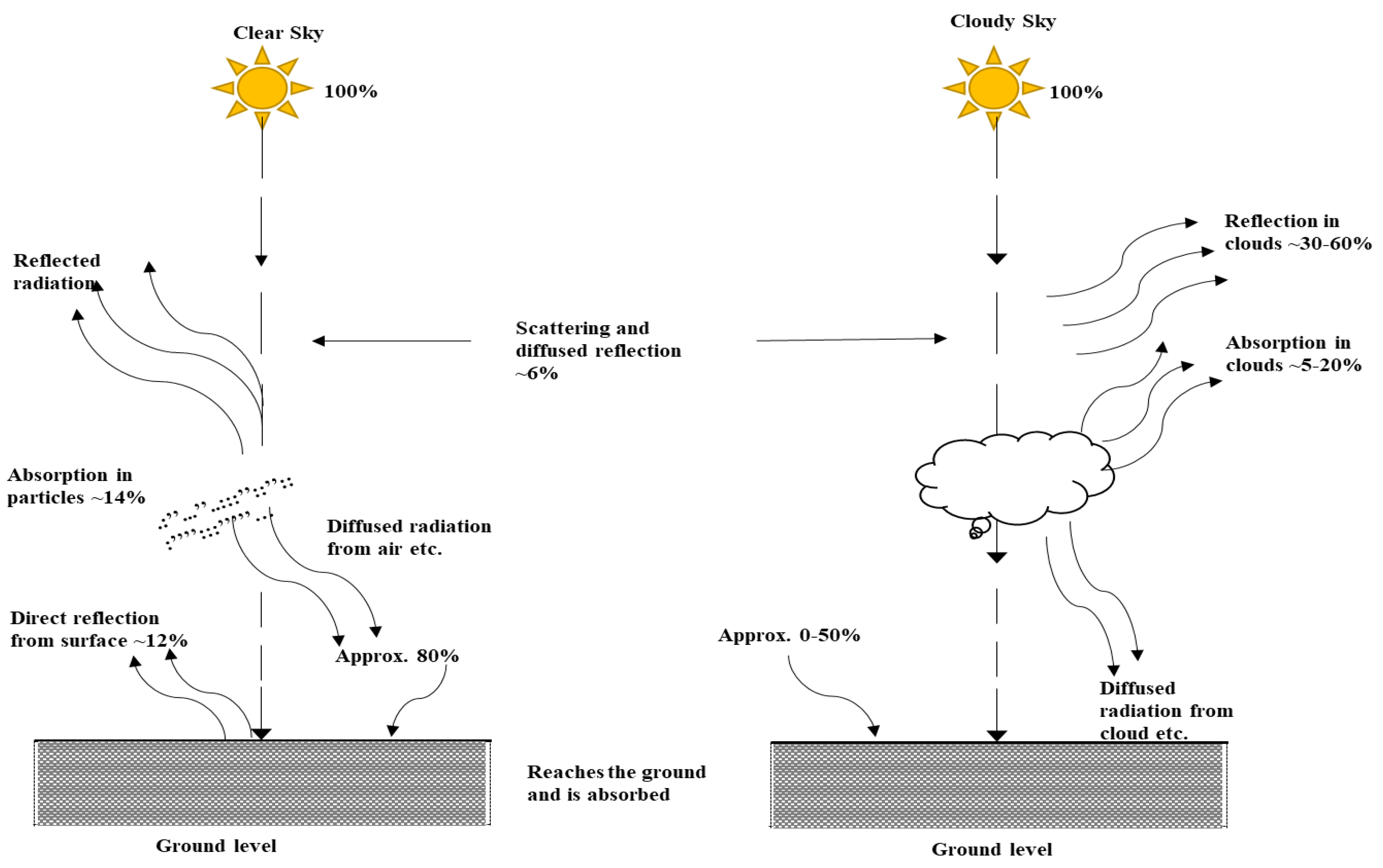
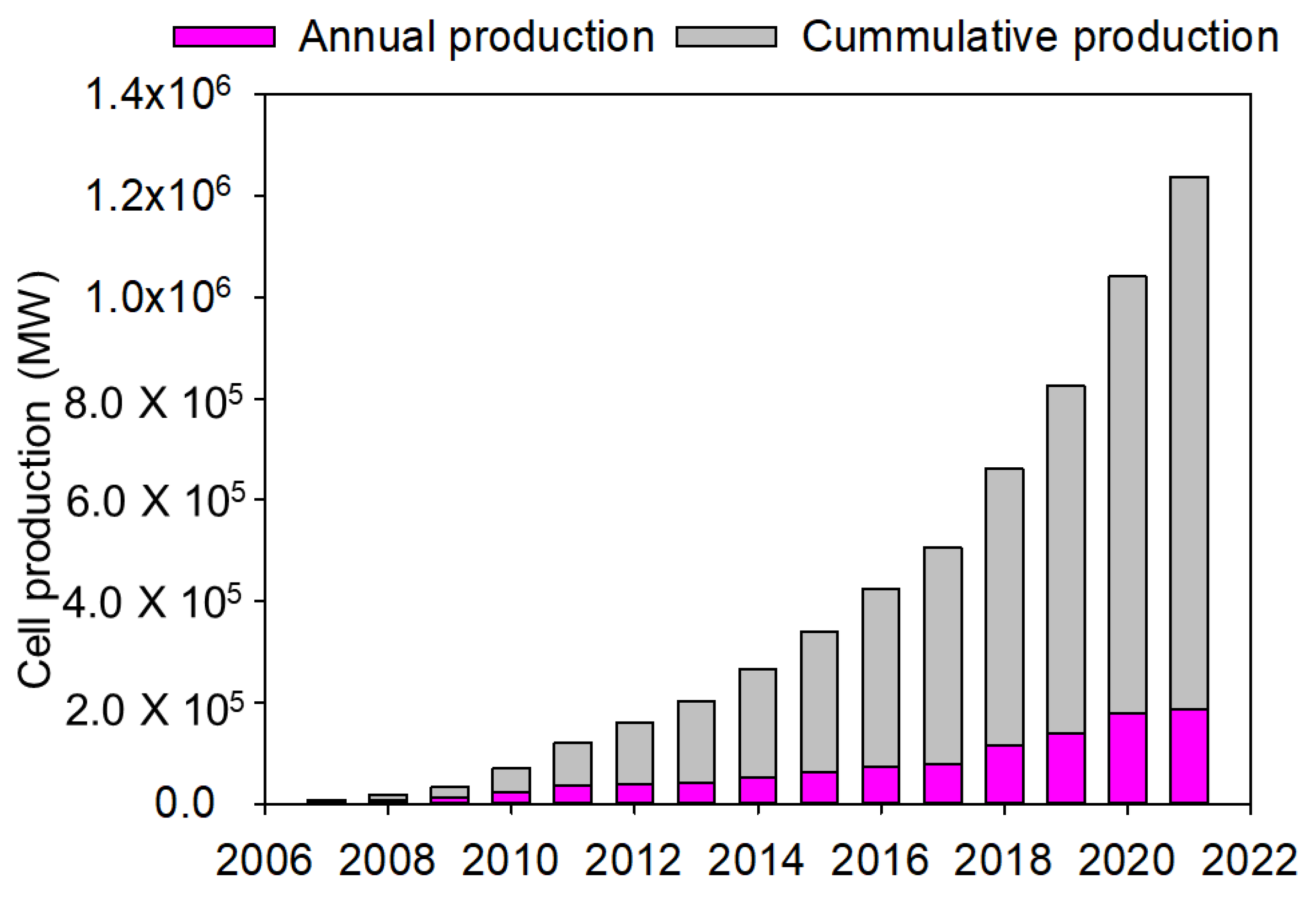
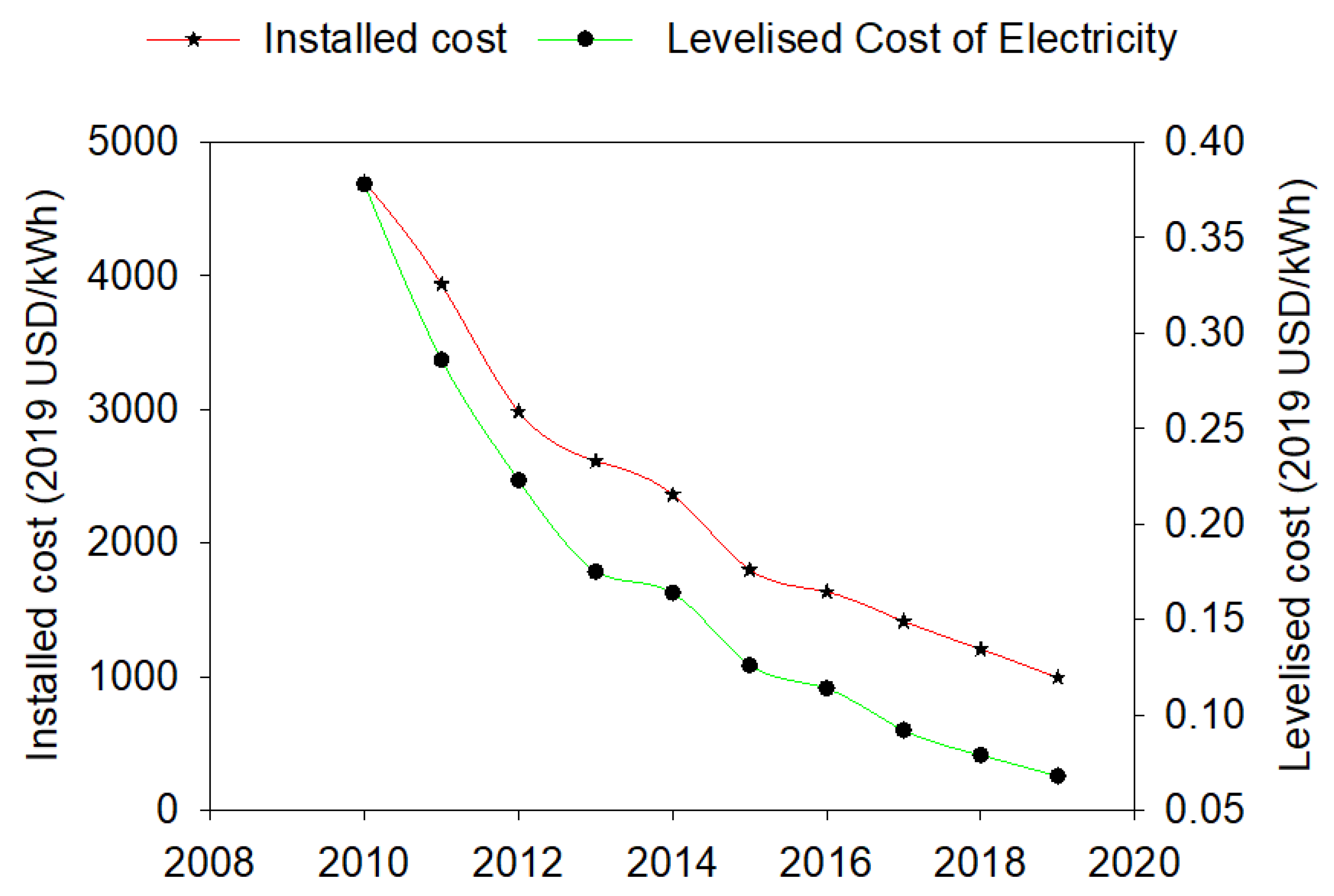
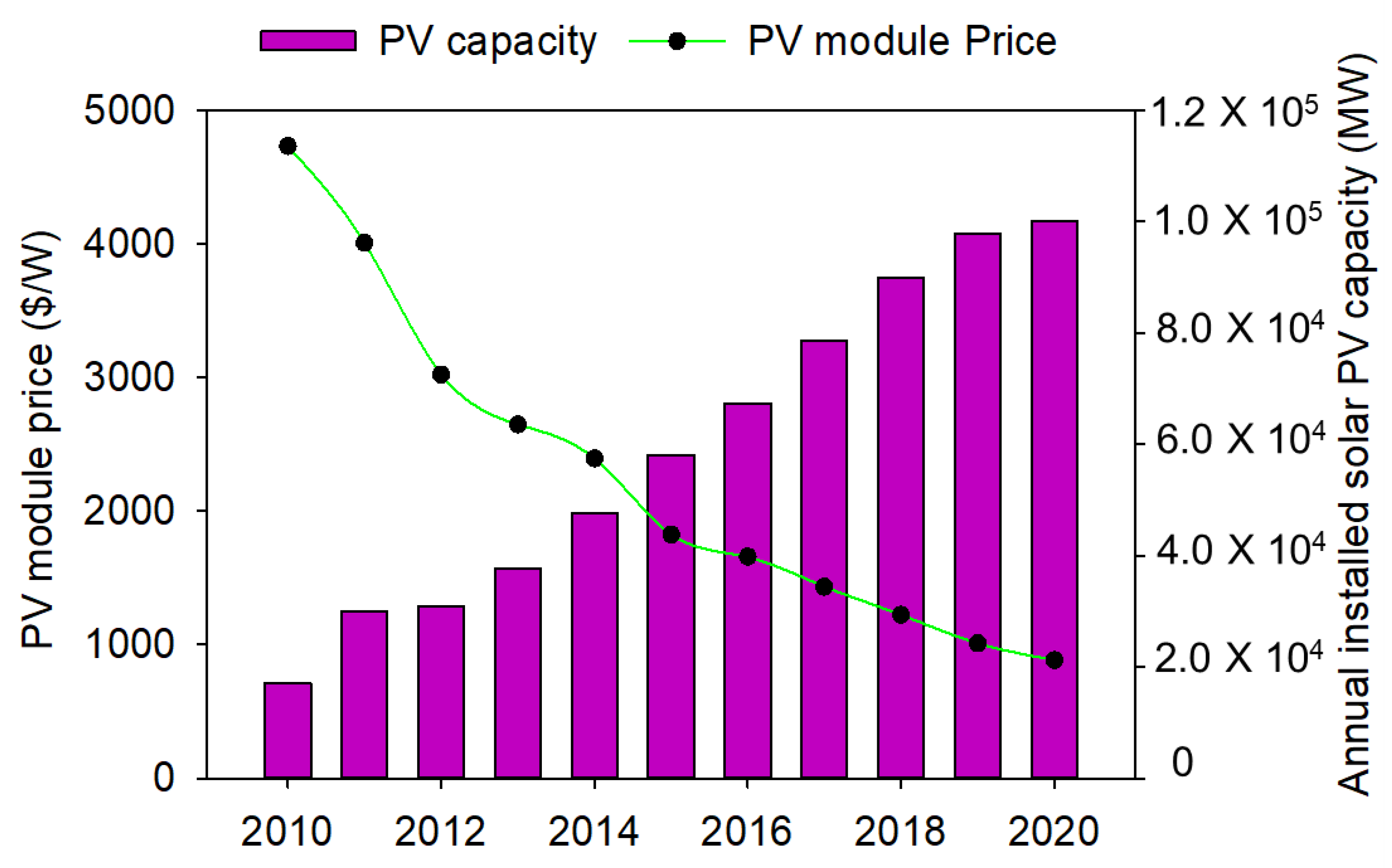

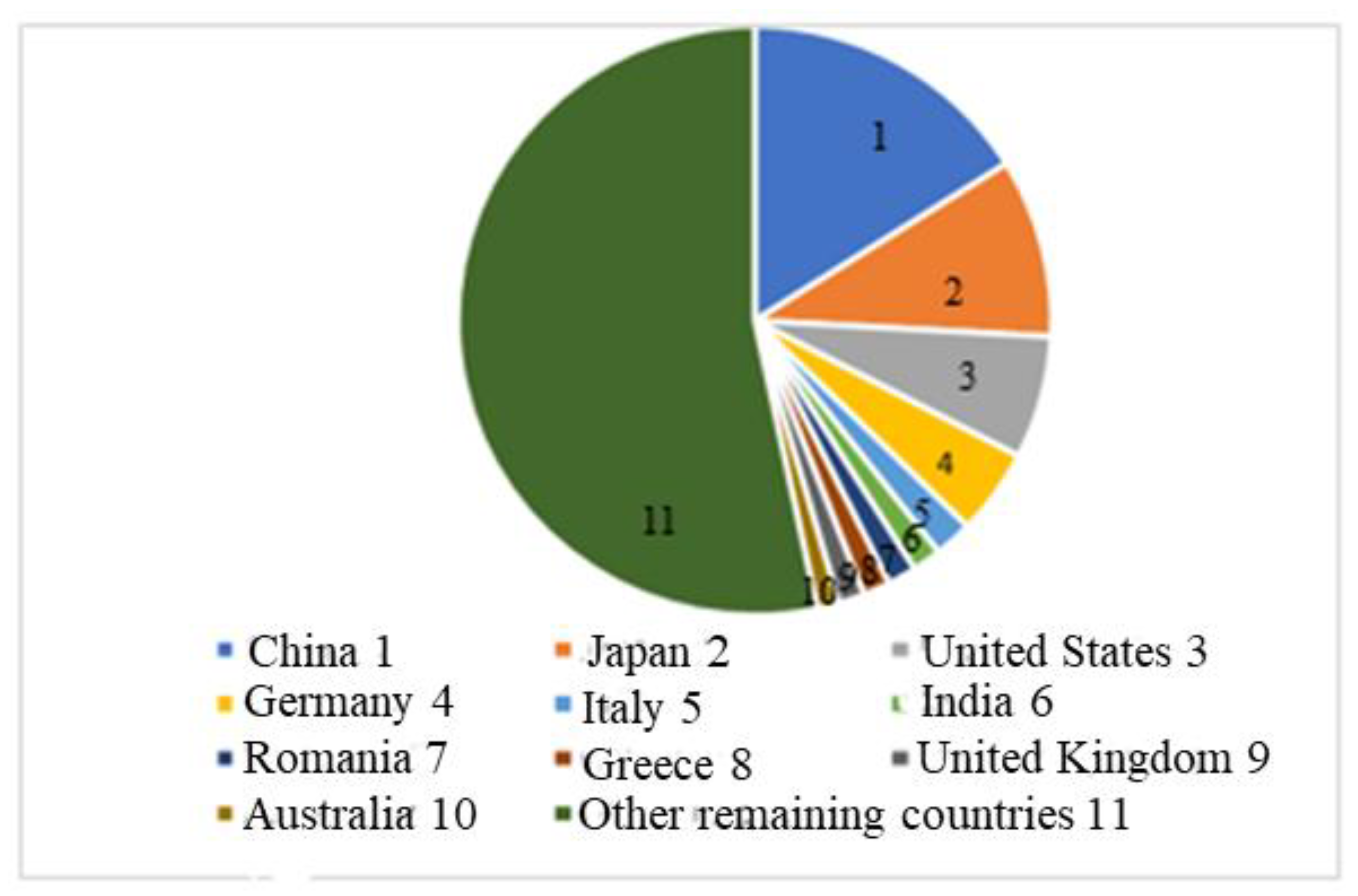
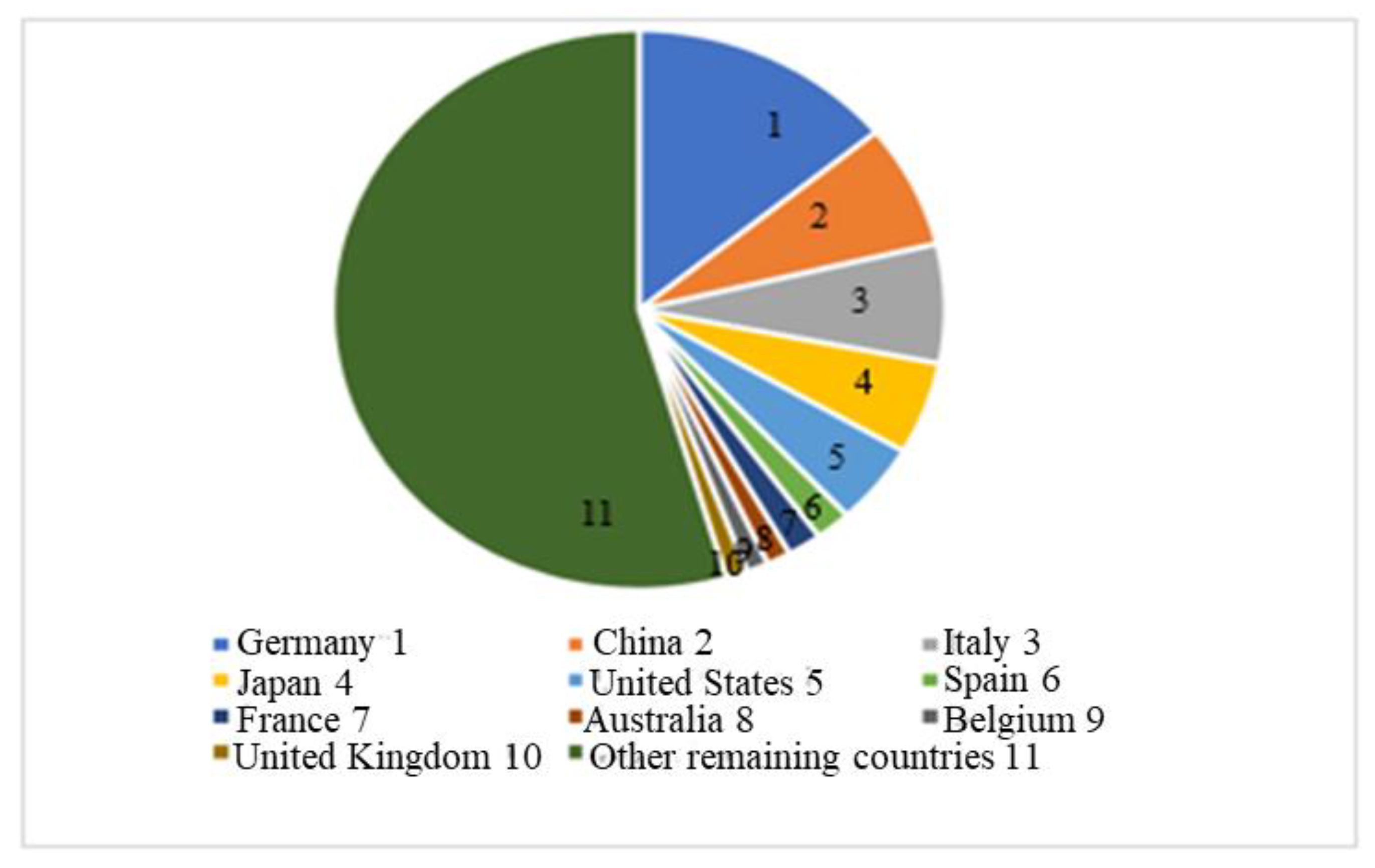
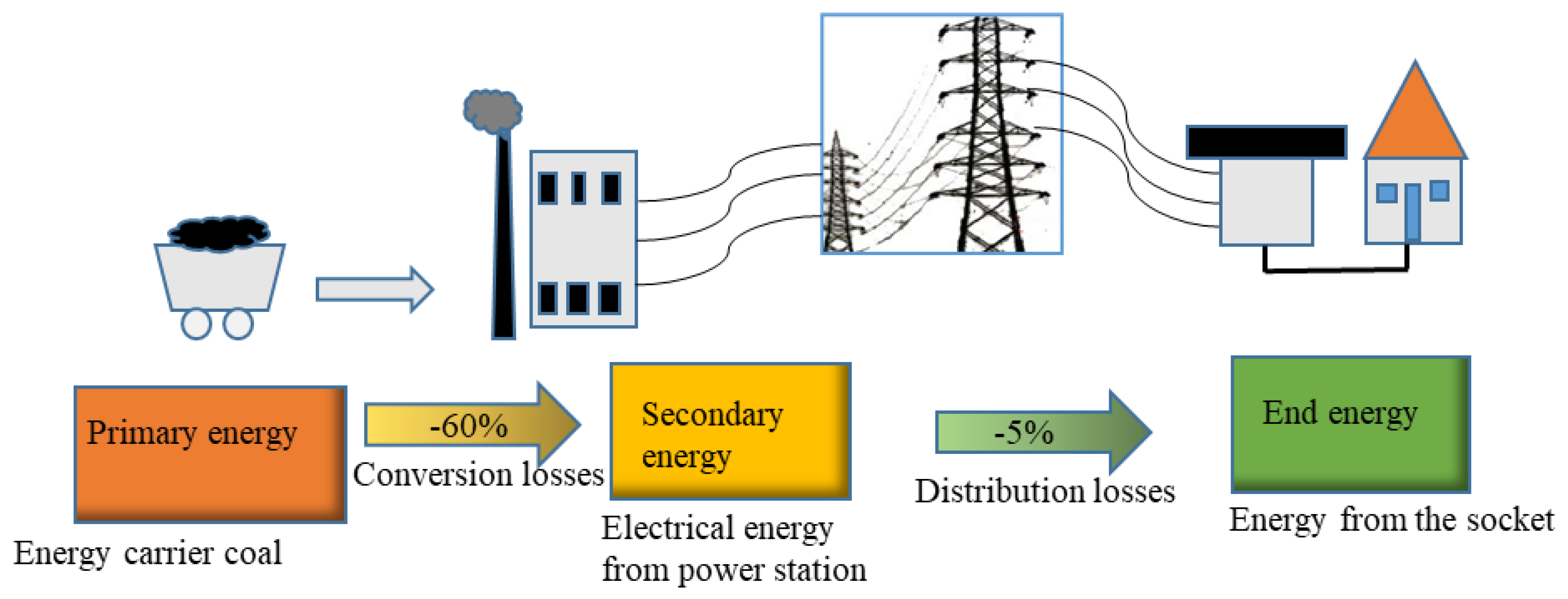

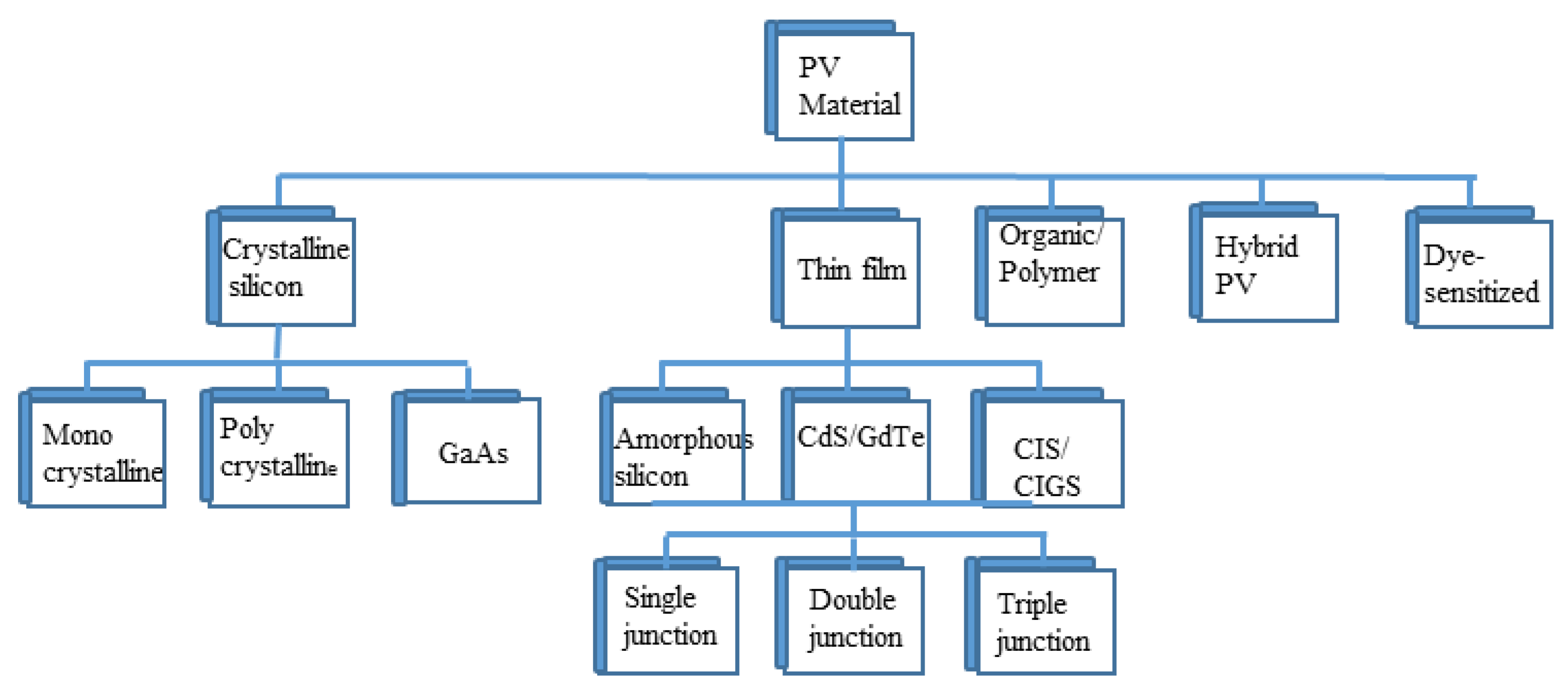

| S/N | Kind | PV Sources of Energy | Fossil Fuel Sources of Energy |
|---|---|---|---|
| 1 | Emission | Discharge zero emissions | Discharges greenhouse gases |
| 2 | Availability | They are infinite | Fuel reserves are finite |
| 3 | Environmental | Are environmentally friendly as well as nontoxic | Toxic to the environment |
| 4 | Climatic change | Rely on the alteration of weather and climate | Independent of weather conditions |
| 5 | Cost | Have a high cost of maintenance and are capital intensive | Low cost of production with cheap transportation |
| 6 | Storage | Require storage between production and consumption | Storage is portable and easy |
| 7 | Development | Create more jobs and have a highly sustainable development | Sustainable development is lower |
| 8 | Transportation | Transported where they are desirable or used where they are obtainable | Need transportation from the production site for further processing. |
| 9 | Distribution | Uniformly distributed worldwide | Distribution is nonuniform and leads to flow gaps and changes in the price |
| 10 | Area | Require large portions of land | A small geographical area is needed |
| 11 | Regeneration | Can be renewed; inexhaustible resource | Ore is exhausted and cannot be renewed |
| 12 | Geographical implications | Limit our dependency on coal and permit self-sufficiency | Over-dependency on coal as a resource can weaken a country’s energy security |
| 13 | Energy Supply | Generate a high amount of energy | Supply is limited |
| Type of Energy | Primary Energy (EJ) | Primary Energy (%) | ||
|---|---|---|---|---|
| 2004 | 2014 | 2004 | 2014 | |
| Wind, solar | 0.8 | 8.5 | 0.2 | 1.6 |
| Nuclear | 26.6 | 24.0 | 5.9 | 4.4 |
| Fossil fuels | 385.2 | 467.2 | 87.2 | 86.3 |
| Country | Geothermal | Solar PV | CSP | Wind Power | Biogas | Solar Heating and Cooling | CSP |
|---|---|---|---|---|---|---|---|
| World | 93 | 3365 | 0 | 1148 | 344 | 807 | 34 |
| China | 1.5 | 2216 | 0 | 510 | 145 | 670 | 11 |
| India | 164 | 0 | 61 | 85 | 17 | ||
| USA | 35 | 233 | 5 | 106 | 713 | 5.2 | |
| Germany | 6.5 | 36 | 160 | 8.9 | 0.6 | ||
| Japan | 2 | 272 | 1 | 5 | 0.7 | ||
| Brazil | 10 | 34 | 42 | ||||
| EU | 25 | 100 | 344 | 34 | 6 |
| S/no | Country | Policy/Regulatory Target | Supply Side Drivers | Demand Side Drivers | Fiscal Incentives | Remarks | References |
|---|---|---|---|---|---|---|---|
| 1 | Germany | Yes | Feed-in-tariff, competitive bidding | Mandatory interconnection | Capital subsidy | Grid parity, capital subsidy now provided for energy storage | [133] |
| 2 | China | Yes | Feed-in-tariff, competitive bidding | Capital subsidy | [158] | ||
| 3 | Japan | Yes | Feed-in-tariff | Net metering | Capital subsidy | Shifted from net to gross metering in 2009 | [158] |
| 4 | Italy | Yes | Feed-in-tariff | [133] | |||
| 5 | USA | Yes | Investment tax credit (ITC) | Renewable portfolio Standard (RPS); net metering | Capital subsidy; tax credits | A few states have gross metering in place | [133] |
| 6 | France | Yes | Feed-in-tariff | [133] | |||
| 7 | Spain | Yes | Feed-in-tariff | Capital subsidy | New projects not eligible for FiT | [133] | |
| 8 | United Kingdom | Yes | Feed-in-tariff | Net metering; renewable obligation (RO) | Capital subsidy | [159] | |
| 9 | Australia | Yes | Feed-in-tariff | Net metering | Capital subsidy | [159] | |
| 10 | India | Yes | Feed-in-tariff; competitive bidding | renewable portfolio obligation (RPO); renewable energy credits (REC) | Capital subsidy; tax holidays | Competitive bidding on tariff | [158] |
Publisher’s Note: MDPI stays neutral with regard to jurisdictional claims in published maps and institutional affiliations. |
© 2022 by the authors. Licensee MDPI, Basel, Switzerland. This article is an open access article distributed under the terms and conditions of the Creative Commons Attribution (CC BY) license (https://creativecommons.org/licenses/by/4.0/).
Share and Cite
Apeh, O.O.; Meyer, E.L.; Overen, O.K. Contributions of Solar Photovoltaic Systems to Environmental and Socioeconomic Aspects of National Development—A Review. Energies 2022, 15, 5963. https://doi.org/10.3390/en15165963
Apeh OO, Meyer EL, Overen OK. Contributions of Solar Photovoltaic Systems to Environmental and Socioeconomic Aspects of National Development—A Review. Energies. 2022; 15(16):5963. https://doi.org/10.3390/en15165963
Chicago/Turabian StyleApeh, Oliver O., Edson L. Meyer, and Ochuko K. Overen. 2022. "Contributions of Solar Photovoltaic Systems to Environmental and Socioeconomic Aspects of National Development—A Review" Energies 15, no. 16: 5963. https://doi.org/10.3390/en15165963







